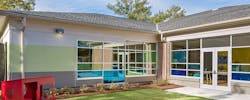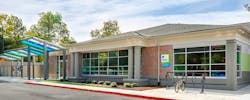Harnessing the Power of Color
Color surrounds the built world everyday. Choosing to frequent a building or establishment, or even choosing to rent a certain apartment space, can be decided based on color.
While the freedom of color has become more commonplace, architects still feel it’s critical for consumers, contractors, and builders—as well as themselves—to have access to limitless opportunities. Neutrals still dominate the market, but new and improved paneling for building exteriors can provide extended options for the industry. Traditional metal panels tend to offer a preset number of colors, limiting designers and builders to utilizing similar hues for projects. To find more variety in color schemes, some architects have turned to Nichiha’s Illumination panels, which provide virtually a limitless color palette.
Jonathan Brown, Senior Associate at JHP Architecture, worked on a project in Austin, Texas, where color was an integral part of the building’s design concept. Described as being part of a cool and funky location, the high-end mixed-use development contains apartments, restaurants, and shopping stores where the former IBM campus used to sit. Fronting the large nine-acre park is The Gallery at the Domain, where Nichiha panels were used at one of the corners to create emphasis, and passersby might notice the “cube” that floats over the glass where the leasing office sits. “When you go to that building, you can’t help but know that that’s exactly where you’re supposed to go looking for an apartment,” Brown says.
Brown’s firm does a lot of master planning in urban development, so they are generally integrating projects into the community. Rather than have projects be an individual building or piece of property, Brown says that they think of it as part of an existing urban fabric, and Nichiha helps facilitate that integration, attributing much of it to color. “With Nichiha you can get very subtle variations in the color because it is a painted panel,” he says. “You can tweak the colors very minutely to get exactly what you want.”
“Libraries these days are just more than a repository for books,” Quinn says. “They are about making, sharing, and creating together, so they are really vibrant places in the community. We loved how we could use the color on the exterior, as well as the interior, to show that vibrancy and that joy.”
Caring about the freedom of color can help architects feel they are invested more in their building, Quinn adds. “It feels very customized to them to get exactly what you want,” she says. “They are not settling for, ‘There’s three colors and you pick this one.’ They get the choice to help convey the message, and in this case for this building it was a message of joy and creativity through color.”
At another project, located in St. Louis, 100 percent of the apartment complex Cortona at Forest Park’s exterior perimeter comprises four different types of Nichiha panels: sandstone, vintage wood, architecture block panel, and the Illumination panels. Different colors (orange, rust red, gray-ish brown) were arranged in a checkerboard pattern for some of the accent corners. Michael Smith, Senior Designer at Humphreys & Partners Architect, says his firm proposed the hues.
“When we started exploring Nichiha, we had seen a couple of examples of that checkerboard pattern being used in previous projects on their website,” he says. “The client gave us a direction that we could explore [a pattern] like that, but the actual color selection was our job.”
The firm typically chooses colors and puts them on a 3-D rendering of the building, looking at several options until a scheme is decided on. Smith feels that architects should care about having the ability to give consumers the freedom to choose so many colors.
“First and foremost, whenever we [utilize] the Illumination panels [for a project], it’s typically at a corner and typically in an important intersection,” Smith explains. “It really gives the building a sense of being a landmark—it’s not just a typical brick building where colors are all the same.”
Smith feels that having the correct color on a building can give it instant landmark recognition. Color flexibility can be crucial for management companies that lease buildings in helping to sell the building or bringing tenants in if a certain hue catches their eye. While Smith says color choice may depend on geographic location, or where the project is located in a certain city, having a client who is willing to take color risks when an extended palette is provided to them can result in some unique buildings that draw people’s attention and business.

